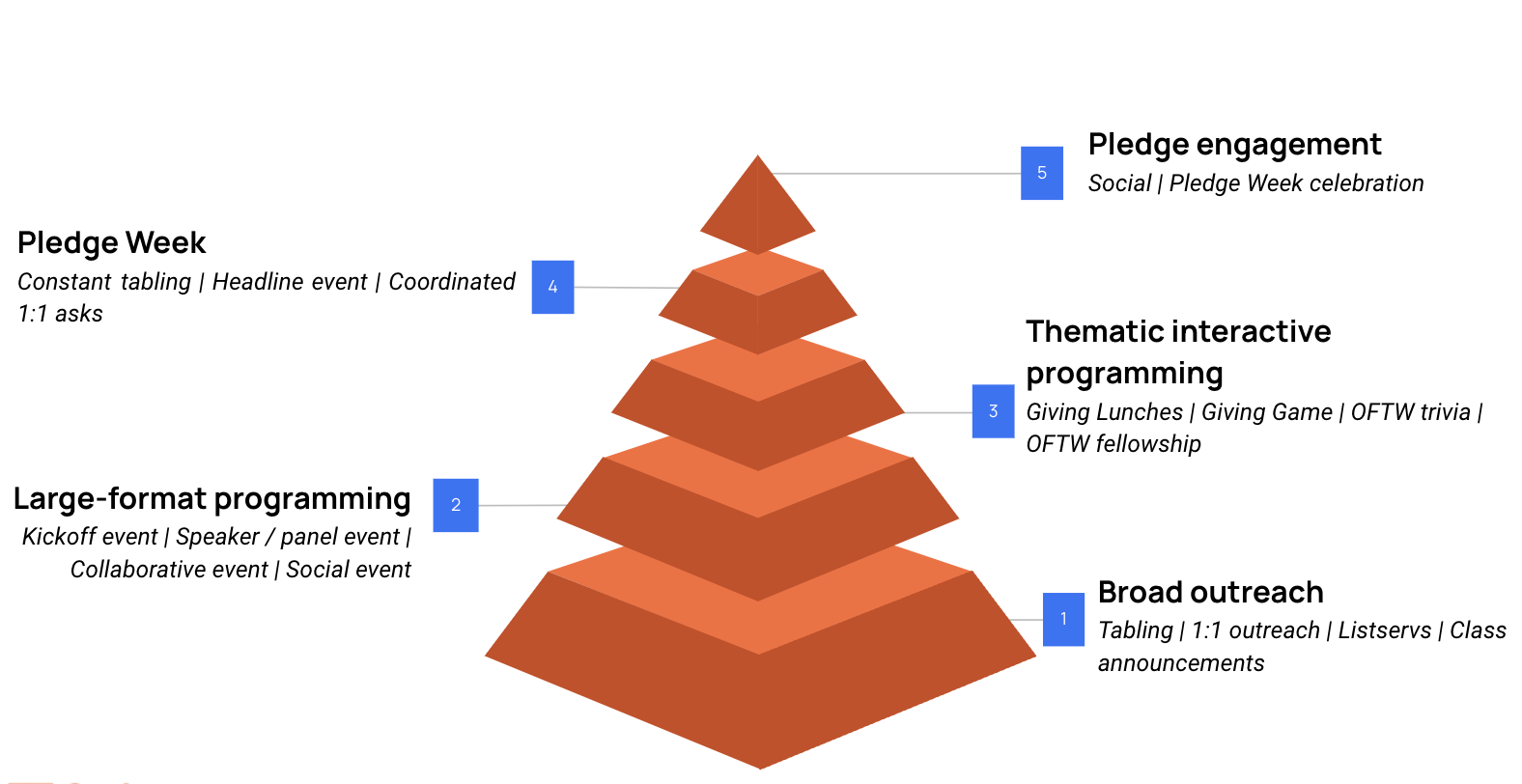Most people will not take the pledge the first time they hear about OFTW, so you need to establish a clear pipeline of engagement so that they have several opportunities to engage with OFTW.
- Consider a friend who hasn’t pledged -- What ‘points of engagement’ will prepare them to pledge? How will you draw them in to those points of engagement?
- Then, scale this up to the entire chapter, and build these ‘points of engagement’ out to multiple events / vectors of outreach that your members can drive turnout to
Contents:
Example of a journey to pledge:

- First, invite the potential pledger to an intro or social event. This is a really easy ask and serves as a casual introduction to your chapter.
- Then invite them to a giving lunch. Now that they have heard of OFTW, you need to engage them in a deeper conversation about giving. A giving lunch is an interactive presentation that challenges attendees to put OFTW's values in conversation with their own.
- Now that they have learned more about the pledge, they might be ready to sign up but they just have not taken the plunge yet. Bringing them to a tabling session during pledge week is a great opportunity to get them signed up, especially because you will have laptops ready to go with the donational page, and you can walk them through the pledge process.
- Finally, invite them to your end of year celebration, where you can thank them for their pledge and share your chapter's impact report from the chapter dashboard. This will create a sense of community which helps ensure that they will not cancel their pledge in the future.
Journey to pledge formula:

Your journey to pledge should start at the bottom of this diagram, with broad outreach, and end at the top with pledge engagement.
- Broad outreach - The goal of broad outreach is to tell as many people as possible that your OFTW chapter exists!
This can include tabling at the clubs fair, 1:1 outreach to your friends and classmates, sending mass emails or making announcements in classes.
- Large-format programming - The goal of this type of event is to take the folks that you contacted through broad outreach and introduce them to OFTW (who we are, what we do, why we do it).
Usually this would be an intro/ kickoff event in the first week of the semester where people can come to find out more about your club, but it could also be a social event such as a bonfire or trivia night.
- Thematic interactive programming - The goal of interactive programming is to help people put OFTW's values in conversation with their own by inviting them to engage in deeper conversations about their giving habits.
This could be a giving lunch, a four week Advocacy program or a giving game!
- Pledge Week - The goal of pledge week is to have as many people take the pledge as possible, particularly those who have already engaged with your previous programming. This is a concentrated period of the semester when you focus on making the ask.
Pledge week usually consists of Tabling every day that week, some larger format event to kickoff the week and funnel new people into your pipeline, some coordinated 1:1 outreach and follow up, and a celebratory/social event to close the week.
- Pledge engagement - The goal of a pledge engagement event is to thank everyone who has already taken the pledge and celebrate your chapter's achievements.
This provides pledgers with a sense of community which will help to prevent them from cancelling their pledge in the future!
Related pages and Key resources
Prospective pledge tracker template (use this to track everyone your team invites into your Journey to pledge!)